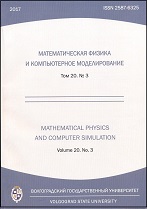|
This article is cited in 2 scientific papers (total in 2 papers)
Modeling, informatics and management
Deployment of the regional climate model for the South of Russia based on RegCM 4.5
A. V. Khoperskov, K. M. Firsov, A. V. Titov, A. A. Razmolov
Volgograd State University
Abstract:
We describe the first stage of the deployment of the regional climate model for Southern Russia based on RegCM 4.5, which requires updating a set of parameterization schemes for subgrid physical processes for the simulated region.
Modeling the general circulation of the atmosphere requires a high rate of calculation of the radiation characteristics, which implies a high degree of parametrization of the radiation transfer equation, in particular molecular absorption charac-teristics.
Molecular absorption has a high selectivity compared with aerosol and molecular scattering in the visible and infrared spectral range, which is a significant problem.
The paper describes calculation schemes in the RegCM radiation block in detail.
Our research shows that the rows of exhibitors provide a high degree of parametrization and high accuracy of calculation comparable to the line-by-line method.
Calculations of fluxes of long-wave radiation with different versions of the HITRAN spectroscopic database show that the differences between downward fluxes are less than 0,1 W/m$^2$ at the lower atmosphere for summer in middle latitudes, and upward fluxes are not more than 0,6 W/m$^2$ at the upper boundary of the atmosphere.
The upstream value at the upper atmosphere is 281,01 W/m$^2$ using the HITRAN2012 spectroscopic database, and our estimate of the downward flux is 351,16 W/m$^2$.
These results indicate that modern spectroscopic databases provide highly accurate calculation of broadband fluxes. To estimate uncertainty in radiation fluxes, we used the continuum absorption model for the H$_2$O vapor, which was used in the entire long-wavelength spectral range except the transpa-rency window 830–1130 cm$^{-1}$, where we used our model based on experimental data.
Initial and boundary conditions are determined from the European Center for Medium-Range Weather Forecast’s ERA-Interim global climate model (EIN 15), and Indian Ocean Sea Surface Temperature (IOSST) data is used to set sea surface temperatures.
The verification phase includes analyzing the choice of the computing area, determining the accuracy of the vertical profiles of parameters, comparing temperature fields using observational data.
We propose to analyze the spatial-temporal characteristics of specific meteorological events, first of all, heavy precipitation, to assess the quality of regional climate models.
This approach seems to be more reliable than the traditional consideration of temperature distributions.
Keywords:
climate simulations, regional climate models, data assimilation, parallelization efficiency.
Received: 02.04.2019
Citation:
A. V. Khoperskov, K. M. Firsov, A. V. Titov, A. A. Razmolov, “Deployment of the regional climate model for the South of Russia based on RegCM 4.5”, Mathematical Physics and Computer Simulation, 22:3 (2019), 68–95
Linking options:
https://www.mathnet.ru/eng/vvgum263 https://www.mathnet.ru/eng/vvgum/v22/i3/p68
|

| Statistics & downloads: |
| Abstract page: | 83 | | Full-text PDF : | 28 |
|




 Contact us:
Contact us: Terms of Use
Terms of Use
 Registration to the website
Registration to the website Logotypes
Logotypes







 Citation in format
Citation in format 
